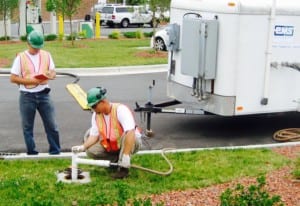 Are you considering the purchase of a commercial property but worry about the legal ramifications of perhaps buying something that contains hidden contamination? As a new property owner, do you worry that you could be liable if you find contamination? Bankers share your concerns! Before they agree to lend money to purchase commercial properties, bankers consider the risks that may affect the borrower’s ability to repay the loan. One of the risks that banker’s consider is the impact of environmental conditions upon the value of the property. Below are the top 5 reasons bankers use a tool called Phase I Environmental Site Assessments to evaluate that risk.
Are you considering the purchase of a commercial property but worry about the legal ramifications of perhaps buying something that contains hidden contamination? As a new property owner, do you worry that you could be liable if you find contamination? Bankers share your concerns! Before they agree to lend money to purchase commercial properties, bankers consider the risks that may affect the borrower’s ability to repay the loan. One of the risks that banker’s consider is the impact of environmental conditions upon the value of the property. Below are the top 5 reasons bankers use a tool called Phase I Environmental Site Assessments to evaluate that risk.
1. Environmental Risk Policy
Banks have established safeguards and controls to limit exposure to potential environmental liability associated with real property. Environmental contamination, and its associated liability, may have significant adverse effect on the value of real estate and may, in certain circumstances, cause a lender to be held directly liable for the environmental cleanup of the property. The cost of such cleanup may exceed, by many times, both the amount of the loan granted to the borrower, as well as the value of the property.
2. Federal Regulations
The Comprehensive Environmental Response, Compensation, and Liability Act (CERCLA or Superfund) authorizes the U.S. Environmental Protection Agency (EPA) to respond to human health and environmental hazards posed by hazardous substances at properties. The courts have applied a strict liability standard under CERCLA. Liability is imposed regardless of fault and can be imposed retroactively (i.e., before CERCLA was enacted). The liability is also joint and several, meaning that liability can be imposed regardless of relative contribution.
Under CERCLA, EPA can require liable parties to conduct cleanups, or EPA can conduct a cleanup and subsequently seek cleanup cost recovery from liable parties. CERCLA defines a liable party as: (1) the current owner and operator of a contaminated property; (2) any owner or operator at the time of disposal of any hazardous substances; (3) any person who arranged for the disposal or treatment of hazardous substances, or arranged for the transportation of hazardous substances for disposal or treatment; and (4) any person who accepts hazardous substances for transport to the property and selects the disposal site.
CERCLA concludes a person is an “owner or operator” of a facility (or property) if that person: (1) owns or operates the facility; or (2) owned, operated, or otherwise controlled activities at that facility immediately before title to the facility, or control of the facility, was conveyed to a state or local government due to bankruptcy, foreclosure, tax delinquency, abandonment or similar means.
i) “Brownfields Amendments”
In 2002, Congress passed the “Small Business Liability Relief and Brownfields Revitalization Act” (Brownfields Amendments). These amendments created a new landowner liability protection from CERCLA for bona fide prospective purchasers (“BFPP”). To qualify as a BFPP, a person must: (1) not be potentially liable for contamination on or at a property; (2) acquire the property after January 11, 2002; (3) establish that all disposal of hazardous substances occurred before the person acquired the facility; (4) make all appropriate inquiries into previous ownership and uses of the property prior to acquiring the property; and (5) not be affiliated with a party responsible for any contamination.
In addition, after purchasing a property, to maintain BFPP status, landowners must comply with “continuing obligations” during their property ownership. To comply with the continuing obligations, BFPPs must: (1) provide all legally required notices with respect to the discovery or release of a hazardous substance; (2) exercise appropriate care with respect to the hazardous substances by taking reasonable steps to stop or prevent continuing or threatened future releases and exposures, and prevent or limit human and environmental exposure to previous releases; (3) provide full cooperation, assistance, and access to persons authorized to conduct response actions or natural resource restoration; (4) comply with land use restrictions and not impede the effectiveness of institutional controls; and (5) comply with information requests and subpoenas.
The 2002 Brownfields Amendments to CERCLA added specific criteria for conducting “all appropriate inquiry” (AAI), added potential liability protections for “contiguous property owners” and “bona fide prospective purchasers,” and required EPA to develop regulations for conducting AAI. Also, to be eligible for an EPA brownfields grant to address contamination at brownfields properties, elegible entities must demonstrate that they are not liable under CERCLA for the contamination at the site. Accordingly, eligible entities who may be considered “potentially responsible parties” under CERCLA must demonstrate they meet one of the liability protections or defenses set forth in CERCLA by establishing that they are:
- an innocent landowner (CERCLA 101(35)(A))

- a contiguous property owner (CERCLA107(q))
- a bona fide prospective purchaser (CERCLA §101(40) and 107(r)), or
- a government entity that acquired (or controls) the property involuntarily though bankruptcy, tax delinquency, or abandonment (CERCLA101(20)(D)); or by exercising its power of eminent domain (CERCLA§101(35)(A)(ii)) . In these instances, an AAI does not have to be conducted prior to acquiring the property, but the entity must exercise “due care” after acquiring the property (CERCLA §101(35)(A) and §§107(b)(3)(a – b)). A Phase I ESA may have to be conducted prior to a cleanup grant application submission.
Property acquisition includes properties acquired by gifts and zero price transactions.
To be eligible for liability protection under CERCLA as an innocent landowner, contiguous property owner, or bona fide prospective purchaser, prospective property owners must:
- Conduct All Appropriate Inquiries in compliance with 40 CFR Part 312, prior to acquiring the property;
- Comply with all Continuing Obligations after acquiring the property. (CERCLA §§101(40)(C – G) and §§107(q)(A) (iii – viii)); and
- Not be affiliated with any liable party through any familial relationship or any contractual, corporate or financial relationship (other than a relationship created by the instrument by which title to the property is conveyed or financed).
ii) Lender Liability for Contamination under CERCLA
Banks that hold mortgages on property as secured lenders are exempt from CERCLA liability, if certain criteria are met. A secured creditor exemption that eliminates owner/operator liability for lenders who hold ownership in a facility primarily to protect their security interest in that facility provided they do not “participate in the management of the facility.”
Generally, “participation in the management” may apply if a bank exercises decision-making control over a property’s environmental compliance, or exercises control at a level similar to that enjoyed by a manager of the facility or property. “Participation in management” does not include actions such as property inspections, requiring a response action to be taken to address contamination, providing financial advice, or renegotiating or restructuring the terms of the security interest.
In addition, the secured creditor exemption provides that simply foreclosing on a property does not result in liability for a bank, provided the bank takes “reasonable steps” to divest itself of the property “at the earliest practicable, commercially reasonable time, on commercially reasonable terms.” Generally, a bank may maintain business activities and close down operations at a property, so long as the property is listed for sale shortly after the foreclosure date, or at the earliest practicable, commercially reasonable time.
3. State Regulations
In addition to CERCLA (Federal), most states have also enacted legislation that establishes similar liability under state law for contamination cleanup costs. Some states have a law which also allows the state to place a super lien status on the property to secure the state’s cost of cleanup. This super lien status may be prior to and senior to the bank’s mortgages and may substantially reduce the value of the bank’s collateral position.
4. EPA’s “All Appropriate Inquiry” Rule
To be eligible for liability protection under CERCLA as an innocent landowner, contiguous property owner, or bona fide prospective purchaser, prospective property owners must conduct “All Appropriate Inquiries” prior to acquiring the property. The AAI Rule sets Federal standards and practices for conducting AAIs.
The AAI rule applies to anyone who is:
- purchasing commercial or industrial property,
- financing or re-financing commercial or industrial property, or
- seeking federal grant money for contaminated site characterization and assessment.
The inquiry of the environmental professional must include:
- interviews with past and present owners, operators, and occupants;
- reviews of historical sources of information;
- reviews of Federal, state, tribal, and local government records;
- visual inspections of the facility and adjoining properties;
- commonly known or reasonably ascertainable information; and
- degree of obviousness of the presence or likely presence of contamination at the property and the ability to detect the contamination.
Additional inquiries that must be conducted by or for the prospective landowner or grantee include:
- searches for environmental cleanup liens;
- assessments of any specialized knowledge or experience of the prospective landowner (or grantee);
- an assessment of the relationship of the purchase price to the fair market value of the property, if the property was not contaminated; and
- commonly known or reasonably ascertainable information.
All Appropriate Inquiries must be conducted or updated within one year prior to acquiring ownership of a property. Certain aspects or provisions of All Appropriate Inquiries (i.e., interviews of current and past owners, review of government records, on-site visual inspection, and searches for environmental cleanup liens) must be conducted or updated within 180 days prior to acquiring ownership of a property.
5. ASTM Standards
EPA recognizes both ASTM International’s E1527 “Standard Practice for Environmental Site Assessments: Phase I Environmental Site Assessment Process” and ASTM E2247 “Standard Practice for Environmental Site Assessments: Phase I Environmental Site Assessment Process for Forestland and Rural Property” as compliant with the All Appropriate Inquiries Regulation. Either of these ASTM International Phase I standards may be used to satisfy the statutory requirements for conducting All Appropriate Inquiries under CERCLA.
The individual who supervises or oversees the conduct of the AAI investigation and signs the final report required in the AAI regulation must meet the definition of an “Environmental Professional” provided in the AAI Final Rule. The final rule defines an environmental professional as someone who possesses sufficient specific education, training, and experience necessary to exercise professional judgment to develop opinions and conclusions regarding conditions indicative of releases or threatened releases on, at, in, or to a property, sufficient to meet the objectives and performance factors of the rule, and has: (1) a state- or tribal-issued certification or license and three years of relevant full-time work experience; or (2) a Baccalaureate degree or higher in science or engineering and five years of relevant full-time work experience; or (3) ten years of relevant full-time work experience.
Do the Reasons Banks Require Phase I Environmental Site Assessments Sound Confusing?
 If all these regulations dealing with environmental liability protection sound confusing, it’s because they are! The stakes are high when dealing with EPA regulations. Make a mistake when purchasing a property and you could potentially be liable for the cost of an environmental disaster that you did not know existed. Understanding EPA regulations and all of their back references and guidance documents is a full time job. Fortunately, at Ambipar Response EMS, Inc., it’s our job. If you need help, please contact us or find more information in our eBook.
If all these regulations dealing with environmental liability protection sound confusing, it’s because they are! The stakes are high when dealing with EPA regulations. Make a mistake when purchasing a property and you could potentially be liable for the cost of an environmental disaster that you did not know existed. Understanding EPA regulations and all of their back references and guidance documents is a full time job. Fortunately, at Ambipar Response EMS, Inc., it’s our job. If you need help, please contact us or find more information in our eBook.


